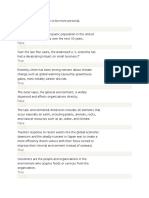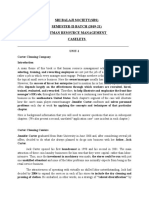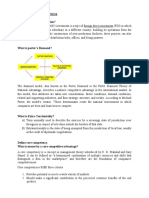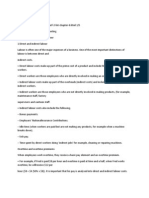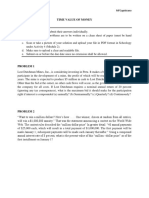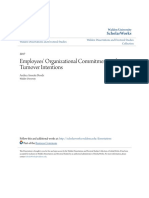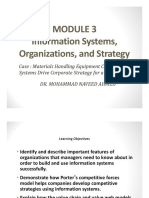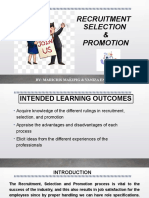Essay/ Short Answer
Essay/ Short Answer
Uploaded by
sunru24Copyright:
Available Formats
Essay/ Short Answer
Essay/ Short Answer
Uploaded by
sunru24Original Description:
Original Title
Copyright
Available Formats
Share this document
Did you find this document useful?
Is this content inappropriate?
Copyright:
Available Formats
Essay/ Short Answer
Essay/ Short Answer
Uploaded by
sunru24Copyright:
Available Formats
Essay/ Short Answer 1. What are the five basic functions of management?
Explain some of the specific activities involved in each function. Is one function more important for human resource management? (easy) Answer: The five basic functions are planning, organizing, staffing, leading, and controlling. Planning activities include establishing goals and standards, developing rules and procedures, and developing plans and forecasting. Organizing activities include giving specific task assignments to subordinates, establishing departments, delegating authority to subordinates, and establishing channels of authority and communication. Staffing activities include determining what type of people should be hired, recruiting prospective employees, and setting performance standards. Leading activities include maintaining morale and motivating subordinates. Controlling activities include setting standards such as sales quotas, and quality standards and taking corrective action as needed. Staffing is the function most readily related to human resource management. However, HR managers actually perform all 5 functions. 2. Explain the difference between line authority and staff authority. What type of authority do human resource managers have? (moderate) Answer: Authority is the right to make decisions, to direct the work of others, and to give orders. Line managers are authorized to direct the work of subordinates and are directly in charge of accomplishing the organizations basic goals. Staff managers are authorized to assist and advise line managers in accomplishing these basic goals. Human resource managers are usually staff managers because they are responsible for assisting and advising line managers in areas like recruiting, hiring, and compensation. However, human resource managers do have line authority within their own department. 3. Human resource managers carry out three distinct functions. List and explain the three functions. (moderate) Answer: The three functions include a line function, a coordination function, and a staff or service function. HR managers exert line authority within the HR department because they direct the activities of the people in that department. HR managers also coordinate personnel activities. In the service function, HR managers assist in hiring, training, evaluating, rewarding, counseling, promoting, and firing employees. They also administer benefit programs and help line managers comply with EEO, occupational health and safety, and labor laws. 4. Explain the meaning of the term nontraditional worker. Provide an example. (easy) Answer: Nontraditional workers include those who hold multiple jobs, or who are contingent or part-time, or people working in alternative work arrangements, or who work as independent contractors.
5.
Some countries are becoming an hour-glass societies. Explain how this change could negatively affect the labor supply and the retirement system. (difficult) Answer: The hour-glass metaphor is used to describe a society whose population is wider in older residents and in children but thinner for people in the workforce. When drawn, the shape resembles an hour-glass. As baby boomers retire, the shape of the American population more closely resembles an hour-glass. There are fewer people to take the jobs that baby boomers left behind. This creates two problems. First, the labor pool is smaller. This creates more demand for retirees, foreign labor, and younger workers. Second, it means that there are fewer people working and supplying funds to the social security system. This threatens the viability of the system funding the retirement of the baby boomers.
6.
Identify five metrics used to evaluate HR performance. (moderate) Answer: There are several possible answers including cost per hire, absence rate, human capital ROI, human capital value added, HR expense factor, health care costs per employee, revenue factor, time to fill, training investment factor, turnover costs, turnover rate, and workers compensation cost per employee.
7.
What are the four categories of proficiencies required today for human resource managers? Explain the meaning of each type of proficiency. (moderate) Answer: The four categories of proficiencies are HR proficiencies, business proficiencies, leadership proficiencies and learning proficiencies. HR proficiencies represent traditional knowledge and skills in such areas as employee selection, training, and compensation. Business proficiencies refer to operations strategy, strategic planning, marketing, production, and finance. Leadership proficiencies include the ability to lead and manage groups. Learning proficiencies include the ability to stay abreast of and apply new technologies.
8.
Employment law increasingly affects the decisions of human resource managers. Name three types of laws and explain the purpose of each one. (moderate) Answer: The three types of laws are equal employment laws, occupational safety and health laws, and labor laws. Equal employment laws set guidelines regarding how the company writes its recruiting ads, what questions its job interviewers ask, and how it selects candidates for training programs. Occupational safety and health laws mandate strict guidelines regarding safety practices at work. Labor laws lay out what the supervisor can and cannot say and do when dealing with unions.
9.
What are the three main ways that technology improves HR functioning? (moderate)
Answer: Technology improves HR functioning through self-service, call centers, and outsourcing. 10. Explain the popularity of HR portals. (easy) Answer: HR portals provide employees with a single access point to all HR information. They let employees and managers access and modify HR information. They streamline the HR process and enable HR managers to focus more on strategic issues. Because they provide a single source of information and the ability for employees to update information directly, they improve efficiency for HR departments.
Chapter 1: Introduction to Human Resource Management Multiple Choice 11. The basic functions of management include all of the following except _____. a. planning b. organizing c. motivating d. leading e. staffing (c; moderate) The management process is made up of _____ basic functions. a. three b. four c. five d. eight e. ten (c; moderate) Which basic function of management includes establishing goals and standards, developing rules and procedures, and forecasting? a. planning b. organizing c. motivating d. leading e. staffing (a; easy) What specific activities listed below are part of the planning function? a. giving each subordinate a specific task b. recruiting prospective employees c. training and developing employees d. developing rules and procedures e. all of the above (d; moderate)
12.
13.
14.
15.
Lin spends most of her time at work setting goals and standards and developing rules and procedures. Which function of management does Lin specialize in? a. planning b. organizing c. motivating d. leading e. staffing (a; easy) Which basic function of management includes delegating authority to subordinates and establishing channels of communication? a. planning b. organizing c. motivating d. leading e. staffing (b; easy) What specific activities listed below are part of the organizing function? a. giving each subordinate a specific task b. recruiting prospective employees c. training and developing employees d. developing rules and procedures e. all of the above (a; moderate) Which basic function of management includes selecting employees, setting performance standards, and compensating employees? a. planning b. organizing c. motivating d. leading e. staffing (e; easy) What specific activities listed below are part of the staffing function? a. giving each subordinate a specific task b. maintaining morale c. recruiting prospective employees d. developing rules and procedures e. both b and c (c; moderate) Which basic function of management includes setting standards such a sales quotas and quality standards? a. planning b. organizing c. controlling d. leading e. staffing
16.
17.
18.
19.
20.
(c; easy) 21. What specific activities listed below are part of the controlling function? a. giving each subordinate a specific task b. recruiting prospective employees c. training and developing employees d. developing rules and procedures e. checking to see how actual performance compares with standards (e; moderate) _____ is the process of acquiring, training, appraising, and compensating employees, and attending to their labor relations, health and safety, and fairness concerns. a. Human Resource Management b. Labor Relations c. Industrial Psychology d. Organizational Behavior e. Organizational Health and Safety Management (a; easy) Human resource management is _____. a. the concepts and techniques used to control people at work b. the process of organizing work activities c. the process of identifying countries with cheaper labor costs and relocating jobs to those countries d. the process of acquiring, training, appraising, and compensating employees, and attending to their labor relations, health and safety, and fairness concerns e. all of the above (d; moderate) _____ is the right to make decisions, to direct the work of others, and to give orders. a. Leadership b. Authority c. Delegation d. Management e. Responsibility (b; easy) _____ are authorized to direct the work of subordinates. a. Line managers b. Staff managers c. Leaders d. Advisory board members e. All of the above (a; easy) _____ are responsible for assisting and advising line managers in areas like recruiting, hiring, and compensation. a. Human resource managers b. Staff managers 5
22.
23.
24.
25.
26.
c. Line managers d. EEO officers e. Board members (a; easy)
27.
Effective human resource management could include all of the following responsibilities except _____. a. placing the right person in the right job b. training employees c. controlling labor costs d. protecting employees health e. all are responsibilities necessary for effective human resource management (e; moderate) Human resource managers generally exert _____ within the human resources department and _____ outside the human resources department. a. line authority; implied authority b. staff authority; line authority c. line authority; staff authority d. functional control; authoritarian control e. staff authority; specific authority (a; difficult) Line managers respect the knowledge human resource managers have in areas such as testing and affirmative action. Consequently, human resource managers can influence line managers through _____. a. line authority b. functional control c. implied authority d. explicit authority e. human capital (c; moderate) Which of the following responsibilities do human resource managers fulfill in their role as employee advocates? a. establish guidelines for how management should be treating employees b. provide support for employees contesting unfair practices c. represent employees interests as appropriate d. all of the above e. none of the above (d; moderate) All of the following are examples of human resource job duties except _____. a. recruiter b. equal employment opportunity coordinator c. financial advisor d. compensation manager e. labor relations specialist (c; moderate)
28.
29.
30.
31.
32.
Which of the following job titles indicates a position in human resources? a. recruiter b. job analyst c. training specialist d. EEO coordinator e. all of the above (e; easy) Which of the following tasks related to recruiting and hiring is not typically handled by HR staff? a. specify necessary job qualifications b. develop pool of qualified applicants c. conduct initial screening interviews d. administer tests e. explain benefits packages (a; easy) The expertise of human resource departments became indispensable with the _____. a. introduction of employment laws b. passing of equal employment laws c. increase of women in the workforce d. movement of jobs to countries with cheaper labor costs e. both a and b (e; moderate; p. 9) _____ refers to the tendency of firms to extend their sales, ownership, and/or manufacturing to new markets abroad. a. Expansion b. Market development c. Globalization d. Export growth e. Diversification (c; easy) Most people who are classified as nontraditional workers are _____. a. contingent workers b. independent contractors c. job sharing d. working multiple jobs e. caring for an elderly parent (b; difficult) Which of the following is a type of nontraditional worker? a. contingent workers b. part-time workers c. people working in alternative work arrangements d. people with multiple jobs e. all of the above (e; moderate)
33.
34.
35.
36.
37.
38.
Jak takes on various projects as an independent contractor. He works on several projects for a variety of companies. When a project is complete, he moves on to another project, often with a different company. Jak is a type of _____. a. contingent worker b. collateral worker c. manager d. consultant e. none of the above (a; moderate) Saras and her mother, Ann share one flight attendant job at Jet Airlines. Saras and Ann could be classified as _____. a. flex-time workers b. contingent workers c. nontraditional workers d. traditional workers e. none of the above (c; easy) What term refers to the knowledge, education, training, skills, and expertise of a firms workers? a. human resources b. human capital c. intangible assets d. knowledge assets e. intellectual property (b; moderate) Which of the following demographic issues represents a challenge for human resource managers? a. increasingly diverse workforce b. aging workforce c. increasing use of contingent workers d. both a and b e. all of the above (d; moderate; p. 13) The proportion of women in the workforce is projected to _____. a. increase significantly over the coming decade b. decrease as more women decide to stay home with children c. stop growing d. increase at a decreasing rate e. decrease at an increasing rate (c; difficult)
39.
40.
41.
42.
43.
Over the next few years, employers may face a severe labor shortage because _____. a. there are fewer people entering the job market than there are retiring baby boomers b. one-third of married women are not in the labor force c. Older workers will represent 11% of the labor force d. people are living longer e. all of the above (a; difficult) What tactic will employers likely have to take to fill openings left by retiring employees? a. instituting flexible work hours b. providing elder care c. hiring more women d. rehiring retirees e. lowering the retirement age (d; difficult) A _____ is a companys plan for how it will balance its internal strengths and weaknesses with external opportunities and threats in order to maintain a competitive advantage. a. SWOT analysis b. mission statement c. strategy d. tactic e. scorecard (c; easy) The performance of human resource departments is evaluated based on _____. a. measurable evidence of efficiency b. measurable evidence of effectiveness c. anecdotal evidence d. qualitative measures of success e. both a and b (e; moderate) Quantitative performance measures used by human resource managers to assess operations are called _____. a. ratios b. benchmarks c. metrics d. grades e. goals (c; moderate)
44.
45.
46.
47.
48.
The _____ metric can be used as a measurement to show improvements to savings in recruitment and retention costs. a. absence rate b. cost per hire c. HR expense factor d. human capital ROI e. time to fill (b; moderate) Which metric indicates the cost of health care per employee by providing the per capita cost of employee benefits? a. HR expense factor b. human capital ROI c. health care costs per employee d. human capital value added e. revenue factor (c; moderate) The _____ metric views human resource expenses in relation to the total operating expenses of the organization. a. HR expense factor b. human capital ROI c. health care costs per employee d. human capital value added e. revenue factor (a; moderate) _____ are a useful tool for determining why employees are leaving an organization. a. Government labor reports b. Exit interviews c. Benchmarks d. HR portals e. Turnover rates (b; easy) Which of the following human resource practices can be useful in reducing workers compensation cost per employee? a. safety training b. disability management c. safety incentives d. all of the above e. a and b only (d; moderate)
49.
50.
51.
52.
10
53.
Which metric views employees as capital rather than as an expense? a. time to fill b. training investment c. HR expense factor d. revenue factor e. none of the above (d; difficult) The _____ measures the rate at which employees leave the company. a. turnover costs b. turnover rate c. time to fill d. cost per hire e. absence rate (b; moderate) When managers use metrics to assess performance and then develop strategies for corrective action, they are performing the _____ function of management. a. planning b. leading c. staffing d. controlling e. organizing (d; difficult) The term _____ means contributing in a measurable way to achieving the companys strategic goals. a. competitive advantage b. achievement success c. value creation d. success metric e. none of the above (c; moderate) Managers use a(n) _____ to measure the HR functions effectiveness and efficiency in producing employee behaviors the company needs to achieve its strategic goals. a. metric b. HR Scorecard c. benchmark d. high performance work system e. MBO format (b; easy)
54.
55.
56.
57.
11
58.
Metrics can be compared against _____ to evaluate an organizations performance. a. last years metric b. competitors metric c. survey data d. national standard e. all of the above (e; easy) The Revenue Factor is equal to _____. a. revenue divided by the total number of full-time equivalents (FTE) b. total days elapsed to fill requisitions divided by the number hired c. revenue minus operating expense minus compensation and benefit cost divided by the total number of full-time equivalents (FTE) d. HR expense divided by the total operating expense e. advertising plus agency fees plus employee referrals plus travel costs of applicant plus relocation costs plus recruiter pay and benefits divided by number of hires (a; difficult) The HR expense factor is equal to _____. a. revenue divided by the total number of full-time equivalents (FTE) b. total days elapsed to fill requisitions divided by the number hired c. revenue minus operating expense minus compensation and benefit cost divided by the total number of full-time equivalents (FTE) d. HR expense divided by the total operating expense e. advertising plus agency fees plus employee referrals plus travel costs of applicant plus relocation costs plus recruiter pay and benefits divided by number of hires (d; difficult) The cost per hire is equal to _____. a. revenue divided by the total number of full-time equivalents (FTE) b. total days elapsed to fill requisitions divided by the number hired c. revenue minus operating expense minus compensation and benefit cost divided by the total number of full-time equivalents (FTE) d. HR expense divided by the total operating expense e. advertising plus agency fees plus employee referrals plus travel costs of applicant plus relocation costs plus recruiter pay and benefits divided by number of hires (e; moderate)
59.
60.
61.
12
62.
The human capital value added is equal to _____. a. revenue divided by the total number of full-time equivalents (FTE) b. total days elapsed to fill requisitions divided by the number hired c. revenue minus operating expense minus compensation and benefit cost divided by the total number of full-time equivalents (FTE) d. HR expense divided by the total operating expense e. advertising plus agency fees plus employee referrals plus travel costs of applicant plus relocation costs plus recruiter pay and benefits divided by number of hires (c; difficult) What metric evaluates retention efforts by an organization? a. turnover costs b. turnover rate c. cost per hire d. absence rate e. both a and b (e; easy) Firms can use the _____ as a benchmark for the cost per hire metric. a. Government employment report b. Cost Per Hire Staffing Metrics Survey c. Employer Costs for Employee Compensation Report d. Government Job Turnover Report e. None of the above (b; easy) Firms can use the _____ as a benchmark for the time to fill metric. a. Government employment report b. Cost Per Hire Staffing Metrics Survey c. Employer Costs for Employee Compensation Report d. Government Job Turnover Report e. None of the above (b; difficult) The concise measurement system used by companies to show the quantitative standards the firm uses to measure HR activities, employee behaviors resulting from the activities, and the strategically relevant organizational outcomes of those employee behaviors is called a(n) _____. a. evaluation system b. HR scorecard c. appraisal system d. evaluation benchmark e. annual report (b; moderate)
63.
64.
65.
66.
13
67.
When seeking to improve the workers compensation cost per employee metric, human resource managers should analyze _____. a. types of injuries b. injuries by department c. injuries by job type d. changes in injuries over time e. all of the above (e; easy) In which area must HR managers be proficient in order to perform well in todays environment? a. HR proficiencies b. business proficiencies c. leadership proficiencies d. learning proficiencies e. all of the above (e; moderate) Mak wants to report the value of the knowledge, skill, and performance of the organizations workforce. To illustrate how employees add value to an organization, Mak should use the _____ metric. a. revenue factor b. human capital value added c. training investment d. HR expense factor e. intangible assets (b; moderate) Of the four categories of proficiencies necessary for HR managers, which one refers to traditional knowledge and skills in areas such as employee selection, training, and compensation? a. HR proficiencies b. business proficiencies c. leadership proficiencies d. learning proficiencies e. staffing proficiencies (a; moderate) Of the four categories of proficiencies necessary for HR managers, which one refers to knowledge of strategic planning, marketing, production, and finance? a. HR proficiencies b. business proficiencies c. leadership proficiencies d. learning proficiencies e. staffing proficiencies (b; moderate)
68.
69.
70.
71.
14
72.
Of the four categories of proficiencies necessary for HR managers, which one refers to the ability to work with and lead management groups? a. HR proficiencies b. business proficiencies c. leadership proficiencies d. learning proficiencies e. staffing proficiencies (c; moderate) Su Han is an HR manager for a large company. The MBA degree she earned prior to taking this position has been helpful to her because it prepared her to better understand the role of strategic planning, marketing, production, and finance in creating a profitable organization. Which category of proficiency has Sus MBA prepared her for? a. HR proficiencies b. business proficiencies c. leadership proficiencies d. learning proficiencies e. staffing proficiencies (b; moderate) Mohan is particularly good at staying abreast of new technologies and practices affecting human resources management. Which proficiency is Mohan skilled in? a. HR proficiencies b. business proficiencies c. leadership proficiencies d. learning proficiencies e. staffing proficiencies (d; moderate) Which of the following types of laws does not affect the decisions of human resource managers? a. equal employment laws b. occupational safety and health laws c. labor laws d. advertising regulations e. all of the above affect the decisions of human resource managers (d; difficult) _____ set guidelines regarding how the company writes its recruiting ads, what questions its job interviewers ask, and how it selects candidates for training programs or evaluates its managers. a. Equal employment laws b. Occupational safety and health laws c. Labor laws d. Advertising regulations e. Fairness in Employment regulations (a; moderate)
73.
74.
75.
76.
15
77.
_____ set guidelines regarding safety practices at work. a. Equal employment laws b. Occupational safety and health laws c. Labor laws d. Advertising regulations e. Fairness in Employment regulations (b; moderate) Which of the following HR activities may be outsourced to specialist service providers? a. administration of 401 (k) pension plans b. employee assistance/ counseling plans c. retirement planning d. background checks e. all of the above (e; moderate) Companies may use a(n) _____ to provide employees with a single access point or gateway on a companys intranet to all human resource information. a. database b. HR portal c. data warehouse d. www e. URL (b; easy) AB Corp streamlined its annual benefits package enrollments by digitizing and aggregating the former paper benefits reports, electronic spreadsheets, and benefit summaries and providing the materials at a single location on the company intranet. AB Corp is using a(n) _____. a. database b. HR portal c. data warehouse d. customer relationship management system e. outsourcing model (b; moderate)
78.
79.
80.
True/ False 81. Staff managers are authorized to direct the work of subordinates and are directly in charge of accomplishing the organizations basic goals. (F; easy) Human resource managers are generally staff managers. (T; easy) Staff managers are always someones boss. (F; moderate) In small organizations, line managers may carry out all personnel duties without the assistance of a human resource staff. (T; moderate) Human resource managers assist in hiring, training, evaluating, rewarding, counseling, promoting, and hiring employees. (T; easy)
82. 83. 84.
85.
16
86.
When human resource managers make sure employees can contest unfair practices, they are carrying out an innovator role. (F; easy) The division of human resource responsibilities for line managers and staff managers varies from organization to organization. (T; moderate) As firms seek to keep costs down, there has been a shift to using more traditional workers. (F; easy) With the aging of its workforce, America is facing a demographic shift as significant as the massive entry of women into the workforce that began in the 1960s. (T; moderate) As baby boomers retire from the workforce, there will be more people entering the labor pool than leaving it. (F; easy) Ratios are quantitative performance measures used to assess operations. (F; moderate) The HR Scorecard is a concise measurement system which shows the quantitative standards the firm used to measure the effectiveness and efficiency of human resource activities. (T; moderate) Human resource management creates value for an organization by engaging in activities that produce the employee behaviors the company needs to achieve its strategic goals. (T; moderate) Unlike other divisions, such as research and development, in an organization, the HR function is not evaluated on the extent to which it creates value for the company. (F; easy) The absence rate is focused on more than any other metric used in an HR Scorecard. (F; easy) Human capital ROI reports the return on investment ratio for employees. (T; easy) The revenue factor shows employees as an expense rather than as capital. (F; moderate) The time to fill metric illustrates the efficiency of the firms recruiting function. (T; moderate) The training investment factor measures the total training cost for all employees taken as a whole. (F; moderate) The acronym FTE used in many of the HR metrics stands for foreign or temporary employees. (F; easy)
87.
88.
89.
90.
91.
92.
93.
94.
95.
96.
97.
98.
99.
100.
17
101.
Turnover rate and turnover costs can both be improved with retention efforts. (T; easy) HR should seek to increase the workers compensation cost per employee by eliminating such practices as disability management. (F; moderate) The most important proficiency of the four highlighted in the text for human resource managers is law proficiency. (F; moderate) Equal employment laws lay out what a supervisor can and cannot say and do when dealing with labor unions. (F; moderate) Employment laws are intended to curb erroneous corporate financial reporting. (F; moderate) Because of employment laws, HR managers must now review and approve a firms financial statements. (F; moderate) Human resource managers must have MBA degrees to be promoted to HR directors. (F; easy) ASP is a special wireless technology used to synchronize various electronic tools like cellular phones and PCs and facilitate employee access to employer online HR services. (F; moderate) Ethical issues such as workplace safety, security of employee records, comparable work, and employee privacy rights are all related to human resource management. (T; moderate) HR portals represent a form of outsourcing. (F; moderate)
102.
103.
104.
105.
106.
107.
108.
109.
110.
18
You might also like
- 5CO03 - Briefing NotesDocument9 pages5CO03 - Briefing NotesLUKE WHITENo ratings yet
- Assignment 2Document8 pagesAssignment 2Anonymous qbVaMYIIZ100% (4)
- Serial Key For SmartPLSDocument1 pageSerial Key For SmartPLSsunru2450% (4)
- Simulado 2021 1 CorrigidoDocument13 pagesSimulado 2021 1 CorrigidokeybytyNo ratings yet
- Chapter 6 Vertical Integration: Strategic Management and Competitive Advantage, 5e (Barney)Document29 pagesChapter 6 Vertical Integration: Strategic Management and Competitive Advantage, 5e (Barney)Hitesh NaikNo ratings yet
- Chapter 6 Short Exercise SolutionsDocument11 pagesChapter 6 Short Exercise Solutionsbaseballjunker4100% (1)
- CHAPTER 1 Introducing Modern ManagementDocument4 pagesCHAPTER 1 Introducing Modern ManagementTaqiuddin YazidNo ratings yet
- Introduction To Business Exam PrepDocument3 pagesIntroduction To Business Exam PrepSeth Timm100% (1)
- IBA Suggested Solution First MidTerm Taxation 12072016Document9 pagesIBA Suggested Solution First MidTerm Taxation 12072016Syed Azfar HassanNo ratings yet
- Chapter 16 Safety, Health, and Risk Management: Human Resource Management, 15e (Dessler)Document45 pagesChapter 16 Safety, Health, and Risk Management: Human Resource Management, 15e (Dessler)moganraj8munusamyNo ratings yet
- Organizational Theory and DesignDocument4 pagesOrganizational Theory and DesignSaima AmirNo ratings yet
- Assignment On Service Marketing MixDocument9 pagesAssignment On Service Marketing MixJannatul FerdausNo ratings yet
- trắc nghiệm và short answer IHRMDocument16 pagestrắc nghiệm và short answer IHRM2154010201haNo ratings yet
- Chap 3 - Job Analysis and Talent ManagementDocument27 pagesChap 3 - Job Analysis and Talent ManagementĐinh HiệpNo ratings yet
- Pas Tut 5Document10 pagesPas Tut 5Đặng Thị Phương Nga 2KT-20ACNNo ratings yet
- HRM Practice QuizDocument30 pagesHRM Practice Quizggsbjrjz95No ratings yet
- Quiz No 1 (HRM)Document2 pagesQuiz No 1 (HRM)Aiman KhanNo ratings yet
- Faculty of Management: Barkatullah University, BhopalDocument50 pagesFaculty of Management: Barkatullah University, BhopalA vyasNo ratings yet
- Chevron CorporationDocument5 pagesChevron CorporationrhonamaeNo ratings yet
- Solutions To Chapter 8 Using Discounted Cash-Flow Analysis To Make Investment DecisionsDocument12 pagesSolutions To Chapter 8 Using Discounted Cash-Flow Analysis To Make Investment Decisionshung TranNo ratings yet
- Exercises of Introduction To Working Capital Management 20.37.28Document5 pagesExercises of Introduction To Working Capital Management 20.37.28Linh NvNo ratings yet
- Financial Statements and Ratio Analysis: True or FalseDocument18 pagesFinancial Statements and Ratio Analysis: True or FalseAbd El-Rahman El-syeoufyNo ratings yet
- Chapter 3Document39 pagesChapter 3bladehero10No ratings yet
- Chapter 2: (Thinking Like An Economist) +question 2,4 Chapter 3Document6 pagesChapter 2: (Thinking Like An Economist) +question 2,4 Chapter 3Phạm HuyNo ratings yet
- HRM Assignment 2Document6 pagesHRM Assignment 2Rachel Rego100% (1)
- Multiple Choice Questions (MCQ) and Answers On Human Resource Management (HRM) - Set 3 - ScholarexpressDocument5 pagesMultiple Choice Questions (MCQ) and Answers On Human Resource Management (HRM) - Set 3 - Scholarexpressdevarshi_shukla0% (1)
- Feasibility Study AssignmentDocument9 pagesFeasibility Study Assignmentbachae2024No ratings yet
- 17E00312 Investment & Portfolio ManagementDocument4 pages17E00312 Investment & Portfolio ManagementBeedam BalajiNo ratings yet
- Benefits of Harmonisation and ConvergenceDocument3 pagesBenefits of Harmonisation and ConvergencemclerenNo ratings yet
- P2 November 2014 Question Paper PDFDocument20 pagesP2 November 2014 Question Paper PDFAnu MauryaNo ratings yet
- Chapter 04Document47 pagesChapter 04john brownNo ratings yet
- FIM Yonas MBDocument20 pagesFIM Yonas MBybegduNo ratings yet
- Management Decision and Control: Learning Objectives and Summary of The ChapterDocument23 pagesManagement Decision and Control: Learning Objectives and Summary of The ChapterRaakeshRockaboyzNo ratings yet
- Chapter 7 QuizDocument13 pagesChapter 7 QuizDaniel IsunzaNo ratings yet
- Đề cươngDocument9 pagesĐề cươngĐinh Trần Đức HoanNo ratings yet
- NNDC - Ican Kaduna Study Centre: Practice Questions On Introduction To Management Accounting A. Multiple Choice QuestionsDocument8 pagesNNDC - Ican Kaduna Study Centre: Practice Questions On Introduction To Management Accounting A. Multiple Choice QuestionsAbdulkadir KayodeNo ratings yet
- Case Study. Angel InvestmentsDocument3 pagesCase Study. Angel InvestmentsInna CruduNo ratings yet
- Chapter 1 An Overview of HRMDocument4 pagesChapter 1 An Overview of HRMNguyễn GiangNo ratings yet
- Case Study 1 1 NestleDocument20 pagesCase Study 1 1 NestleballckNo ratings yet
- Microsoft's Make-or-Break Decision: Selecting The Next CEO: Case Application (Managerial Skills)Document2 pagesMicrosoft's Make-or-Break Decision: Selecting The Next CEO: Case Application (Managerial Skills)ThảooNguxiiNo ratings yet
- Corporate Culture: The Ultimate Strategic Asset (eBook PDF) 2024 scribd downloadDocument41 pagesCorporate Culture: The Ultimate Strategic Asset (eBook PDF) 2024 scribd downloadiguethgevehi100% (2)
- Case Study-1,2,3,4&5Document9 pagesCase Study-1,2,3,4&5AtharvNo ratings yet
- Exploring The Challenges and Benefits For ScalingDocument19 pagesExploring The Challenges and Benefits For ScalingSubham SaveraNo ratings yet
- Financial Management Chapter 1Document47 pagesFinancial Management Chapter 1nida.rasheed355No ratings yet
- Leadership and Change Management (LCM) Full PPTDocument238 pagesLeadership and Change Management (LCM) Full PPTf6081321100% (2)
- Business Economics 29118041 Prasta Chapter 6Document5 pagesBusiness Economics 29118041 Prasta Chapter 6dum dum100% (2)
- International Business What Is Greenfield Operation?Document23 pagesInternational Business What Is Greenfield Operation?Ravichandra S MNo ratings yet
- Financial Management (Problems)Document12 pagesFinancial Management (Problems)Prasad GowdNo ratings yet
- CH 16 Sales Forecasting and BudgetingDocument16 pagesCH 16 Sales Forecasting and BudgetingJaehyun PeachNo ratings yet
- UNIT 4 Problem Solving & Decicion MakingDocument20 pagesUNIT 4 Problem Solving & Decicion MakingM.TrangNo ratings yet
- MARGINAL COSTING ExamplesDocument10 pagesMARGINAL COSTING ExamplesLaljo VargheseNo ratings yet
- Leadership and Change Management Chapter 1Document12 pagesLeadership and Change Management Chapter 1sabit hussenNo ratings yet
- TUTORIAL 2 Cost ClassificationDocument7 pagesTUTORIAL 2 Cost Classificationsarahayeesha1No ratings yet
- Exposure Theory of EntrepreneurshipDocument9 pagesExposure Theory of EntrepreneurshipIsidore MapanoNo ratings yet
- Chap 1 Managers in The WorkplaceDocument28 pagesChap 1 Managers in The WorkplaceSahar Hayat AwanNo ratings yet
- Unit 6 - VocabularyDocument1 pageUnit 6 - VocabularynuraldylaNo ratings yet
- Dabur India - Working Capital and Cost ManagementDocument15 pagesDabur India - Working Capital and Cost ManagementhiteshvNo ratings yet
- Accounting For LabourDocument10 pagesAccounting For LabourTaleem Tableeg100% (1)
- Test Bank For Organizational Behavior 1st Edition by NeubertDocument20 pagesTest Bank For Organizational Behavior 1st Edition by Neuberta536440398100% (1)
- Chapter 04Document68 pagesChapter 04raiNo ratings yet
- Time Value of Money General Instructions:: Activity 4 MfcapistranoDocument2 pagesTime Value of Money General Instructions:: Activity 4 MfcapistranoAstrid BuenacosaNo ratings yet
- Chapter - 10 - Pay - For - Performance - Incentive - Rewards - 9eDocument17 pagesChapter - 10 - Pay - For - Performance - Incentive - Rewards - 9ePriyanjaliNo ratings yet
- Value Chain Management Capability A Complete Guide - 2020 EditionFrom EverandValue Chain Management Capability A Complete Guide - 2020 EditionNo ratings yet
- Recruitment Process Outsourcing A Complete Guide - 2020 EditionFrom EverandRecruitment Process Outsourcing A Complete Guide - 2020 EditionNo ratings yet
- HRM SummaryDocument8 pagesHRM SummaryElla Mae BatallerNo ratings yet
- The Validation of The Turnover Intention ScaleDocument138 pagesThe Validation of The Turnover Intention Scalesunru24No ratings yet
- Job Satisfaction and Turnover Intentions: The Moderating Role of Positive AffectDocument4 pagesJob Satisfaction and Turnover Intentions: The Moderating Role of Positive Affectsunru24No ratings yet
- Entry of Jio in Telecommunication Sector in A Competitive EnvironmentDocument4 pagesEntry of Jio in Telecommunication Sector in A Competitive Environmentsunru24No ratings yet
- Medi Caps University Indore: Form IDocument1 pageMedi Caps University Indore: Form Isunru24No ratings yet
- Case StudyDocument28 pagesCase Studysunru24No ratings yet
- Brochure - Workshop On RDocument5 pagesBrochure - Workshop On Rsunru24No ratings yet
- 2020 International Conference On Partial Least Squares Structural Equation Modeling (PLS-SEM)Document1 page2020 International Conference On Partial Least Squares Structural Equation Modeling (PLS-SEM)sunru24No ratings yet
- BOOK Presentation Schedule (F)Document1 pageBOOK Presentation Schedule (F)sunru24No ratings yet
- QP SHRM Old PaperDocument2 pagesQP SHRM Old Papersunru24No ratings yet
- International Conference Brochure IIT Roorkee 2017Document2 pagesInternational Conference Brochure IIT Roorkee 2017sunru24No ratings yet
- Dynamic Student Report 30-12-2016Document63 pagesDynamic Student Report 30-12-2016sunru24No ratings yet
- Dynamic Student Report 30-12-2016Document63 pagesDynamic Student Report 30-12-2016sunru24No ratings yet
- Attempt All QuestionsDocument3 pagesAttempt All Questionssunru24No ratings yet
- Attempt All QuestionsDocument2 pagesAttempt All Questionssunru24No ratings yet
- Information Search Process With Special Reference To Consumer PerceptionDocument1 pageInformation Search Process With Special Reference To Consumer Perceptionsunru24No ratings yet
- Summer Training Project Report ON: Master of Business AdministrationDocument25 pagesSummer Training Project Report ON: Master of Business Administrationsunru24No ratings yet
- AttestationSheet MBA IV 105 StudentsDocument106 pagesAttestationSheet MBA IV 105 Studentssunru24No ratings yet
- SDM (AK) - Mid Sem-3Document2 pagesSDM (AK) - Mid Sem-3sunru24No ratings yet
- User Manual - AQIS Application - TGS - Version 1.0Document35 pagesUser Manual - AQIS Application - TGS - Version 1.0sunru24No ratings yet
- CS (SB) - Mid Sem-1Document1 pageCS (SB) - Mid Sem-1sunru24No ratings yet
- QM (PS) - Mid Sem-1Document3 pagesQM (PS) - Mid Sem-1sunru24No ratings yet
- Attempt All QuestionsDocument1 pageAttempt All Questionssunru24No ratings yet
- QM (PS) - Mid Sem-1Document3 pagesQM (PS) - Mid Sem-1sunru24No ratings yet
- HRPD (SM) - Mid SemDocument1 pageHRPD (SM) - Mid Semsunru24No ratings yet
- MFS (MJ) - Mid Sem-3Document1 pageMFS (MJ) - Mid Sem-3sunru24No ratings yet
- SDM (AK) - Mid Sem-3Document2 pagesSDM (AK) - Mid Sem-3sunru24No ratings yet
- 202312_Wage and Income_ESCO_106257242707Document5 pages202312_Wage and Income_ESCO_106257242707arianaflores142No ratings yet
- 107 Direct and ControllingDocument6 pages107 Direct and ControllingMaria Janina MarianoNo ratings yet
- Advanced Human Resources EnglishDocument30 pagesAdvanced Human Resources EnglishRazan BashaNo ratings yet
- 05 General Conditions of Contract-PRELIMINARIESDocument54 pages05 General Conditions of Contract-PRELIMINARIESSudha ReddyNo ratings yet
- Harvesting Despair 00 161-169 Francine Frankel PDFDocument9 pagesHarvesting Despair 00 161-169 Francine Frankel PDFparulNo ratings yet
- Fuentes, Et Al. v. NLRC. Et Al. 226 SCRA 24Document4 pagesFuentes, Et Al. v. NLRC. Et Al. 226 SCRA 24FranzMordenoNo ratings yet
- TC L1Document10 pagesTC L1Anderson HoNo ratings yet
- Quality Service ManagementDocument35 pagesQuality Service ManagementenriqueterronesNo ratings yet
- 567 1269 1 PBDocument5 pages567 1269 1 PBSkumaresh RaghavanNo ratings yet
- Information Systems, Organizations, and StrategyDocument51 pagesInformation Systems, Organizations, and StrategyShaoli MofazzalNo ratings yet
- 3-PNCC Vs MandaganDocument11 pages3-PNCC Vs MandaganLexter CruzNo ratings yet
- First Day at Work Ingles 61Document7 pagesFirst Day at Work Ingles 61Fredy Rodrigo Gomez SissaNo ratings yet
- Ntuc Workfare CourseDocument7 pagesNtuc Workfare Coursebcr1vtj5100% (2)
- People (V) FerrerDocument5 pagesPeople (V) FerrerEmmanuel RosalesNo ratings yet
- SET Gould-Williams2005Document25 pagesSET Gould-Williams2005Md Shawfiqul IslamNo ratings yet
- Sample Letters of Corrective Action StepsDocument9 pagesSample Letters of Corrective Action StepsevilmurdocNo ratings yet
- RECRUITMENT SELECTION AND PROMOTION FinalDocument41 pagesRECRUITMENT SELECTION AND PROMOTION FinalVaniza EnteroNo ratings yet
- Unemployment in IndiaDocument17 pagesUnemployment in IndiaGaurav SokhiNo ratings yet
- Labor Market Distributive Gains and Cumulative Causation Insights From The Brazilian EconomyDocument27 pagesLabor Market Distributive Gains and Cumulative Causation Insights From The Brazilian EconomyGuilhermeNo ratings yet
- FS Reserba 2.1 PDFDocument37 pagesFS Reserba 2.1 PDFLawrence HamoNo ratings yet
- Employability QuotientDocument16 pagesEmployability QuotientSaravanan ShanmugamNo ratings yet
- Case Digest: Halagueña, Et Al. Vs PAL GR No. 172013Document1 pageCase Digest: Halagueña, Et Al. Vs PAL GR No. 172013kaiaceegeesNo ratings yet
- MBA 1st Year Syllabus 07042021Document37 pagesMBA 1st Year Syllabus 07042021GOD StrikesNo ratings yet
- Microfinance in Nepal PartDocument11 pagesMicrofinance in Nepal PartDipesh MagratiNo ratings yet
- Significant Causes and Effects of Variation Orders in Construction ProjectsDocument10 pagesSignificant Causes and Effects of Variation Orders in Construction Projectschinedu ugwuNo ratings yet
- Serrano vs. Gallant Maritime ServicesDocument2 pagesSerrano vs. Gallant Maritime Serviceskaren igana100% (2)






















